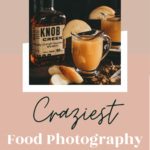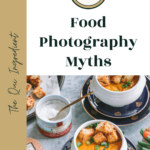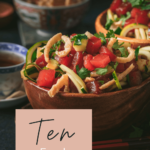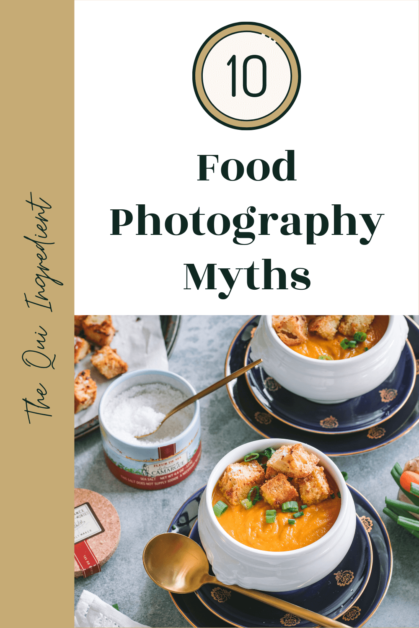Hi There!
I'm Quiana adams
I am a food photographer and stylist, recipe developer, and educator, providing professional services for brands and insightful education for hobbyists and aspiring food photographers alike.
Recipes
Resources
Guides
categories
find me on Instagram
props i love
visit the prop shop
No photoshoot is complete without the right props.
looking for coaching?
BOOK now
10 Food Photography Myths




Starting in food photography can feel overwhelming. Trust me; I’ve been there. I shot for 16 years in the wedding industry. When I came into the food industry, it was a completely different beast.
Today I’m going to share the top 10 food photography myths. If you are new to food photography, you are probably going to hear these myths sometime in the future if you haven’t already.
1. You Must Know How To Cook
You don’t have to know how to cook or even enjoy cooking to become a food photographer. It helps, but if you really want to become a food photographer, I encourage you to do it.
If you read my post on 20 no-cook foods that you can add to your portfolio right now, you can get started photographing food without even turning on your stove.
2. You Must Have A Food Blog
Food photography definitely helps if you want to have a food blog, but you don’t have to have a food blog to become a food photographer. Food photography may be a hobby, you can work with clients, or become an influencer without ever starting a food blog.
3. You Must Have A Studio
Your studio can be wherever you want it to be. If you set up your studio where you have the best natural light, and you can maneuver and get around there quickly and easily, that can be your dedicated studio space. You don’t need a room entirely dedicated to photography to take your photographs.
4. There Is An Age Limit On Creativity
It doesn’t matter if you are a teenager, in your 20s, 30s, 40s, 50s, or 60s. If you have a passion for food photography, do it. It doesn’t matter how old you are.
If you are letting age stand in the way of you pursuing food photography, let that go right now. Food photography is a passion that can be pursued by anyone of any age. Stop letting your age hold you back.
5. You Must Have Fancy Camera Equipment
You do not need fancy camera equipment. As the old saying goes, “The best camera is the one you have with you.” If your camera is a smartphone right now while you are saving up to get a more advanced camera, then use that. There is no shame in where you are in your equipment journey. You don’t need fancy equipment, you just need to learn as much as you can about food photography.
6. You Must Work Full-Time
While some people may be full-time food photographers, many are not. Not all of the food photographers that you love, admire, and follow have food photography as a full-time job.
7. Food Photography Is A Glamorous Job
Food photography is not easy. Well-established photographers in the industry hire assistants to delegate the tasks that they no longer want to do. In the beginning, you are doing it all.
8. You Must Have Several Props To Be Good
As you are developing your visual voice, there are a lot of things that you are going to begin to notice once you start to pay attention to your style. It doesn’t make sense to go out and spend a lot of money and buy props in the beginning.
Like with many things, your style will develop and change, and you want to make sure that the props that you get fit your aesthetic as you grow. Start simple in the beginning. You just need a few key items to start your collection, and you can build from that.
9. You Must Be A Content Expert
In the beginning, it is okay to mimic. Imitation is the best form of flattery. As you grow and start developing your own content, you’ll notice things in your work like, “I see a lot of green in my photographs,” or, “I really like directions lighting from the left.” Over time, you will begin to understand what your visual voice is.
10. Courses Are A Magic Bullet
Courses and workshops are there as tools to help you grow. There is no course out there that you can take to improve your skills instantly unless you do the work.
My husband and I have this saying that we tell our kids when they are learning a new skill and want to give up, “You have to try it 100 times before you give up.” It’s through those tough times and through those moments that you feel like giving up that you learn the most, that you have the breakthroughs. You will see your work improve.
If you look back a year from now at the work that you’ve created, you are going to see a big difference. Especially if you are consistent and you implement the things that you learn. When it gets hard, keep going.
The courses that you buy are great resources, but, ultimately, the work comes from you. Make sure to keep shooting.
Have you heard any of these myths? Are you struggling with them now? If so, put them down in the comments below. Also, if there are other myths that you have heard, put them in the comments below.
Add To Pinterest

Leave a Reply Cancel reply
You must be logged in to post a comment.
Done-For-You Seasonal Content Delivered To Your Inbox
Join The Qui Ingredient community to receive drag and drop content ideas planning tools and new backdrop releases.
find me on instagram - @thequiingredient
Menu
Homepage
About Quiana
work with me
subscribe to the newsletter
Copyright © The Qui Ingredient
Designed by Gillian Sarah
terms & Conditions
site notice
I am a food photographer, educator, and recipe developer, sharing my passion for bringing flavor to life through stunning visuals.
Hey there,
Privacy Policy
Disclaimer
read the blog